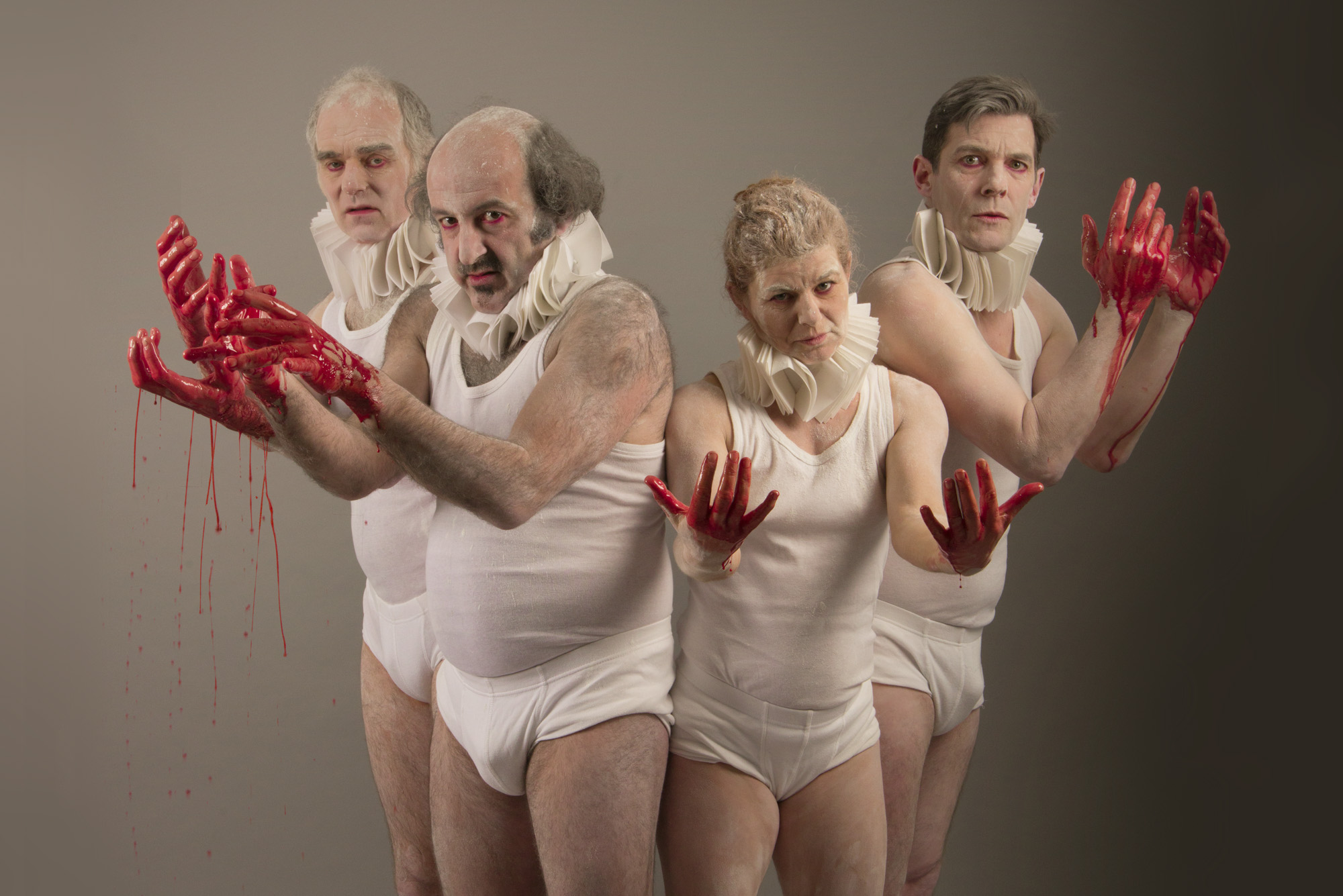As flies to wanton boys are we to the gods, and as flies they are struck down, one by one. The Richards and the Henries. Antony. Cleopatra. Romeo. Juliet. Lear. Macbeth. Hamlet. And the lesser people, them too. All of them. 23 stabbings, 12 sword fights, 5 poisonings, 12 suicides, 2 throats cut, 1 smothering, 3 natural causes, 4 deaths by wounds, 2 explosions, 2 heartbreaks, 3 mob killings, 2 beatings, 3 miscellaneous.
Oh, you’re thinking, you’re clever to have kept such a detailed tally. Not me, Tim Crouch. His catalogue is listed in the programme notes. ‘Filleting out’ the deaths was the first task he set himself as adaptor/director.
But someone is keeping a live score as well. It’s the nice lady in the neat sweater and secretarial spectacles, sat behind the table to the side of the stage. Ding! And another one bites the dust. Ding ding! Two more gone. End of round 4. The neon numbers clunk down. Gosh, we think at the start – 76! (That’s 75 onstage human deaths plus one black ill favour’d fly from Titus Andronicus.)
Spymonkey’s ‘pompous pedagogue’ Toby Park warns us at the start that we are only getting the onstage deaths. So no Mercutio (groan). No Lady Macbeth (gasp). And no Ophelia (boo). It’s a lively audience tonight. They fight back. Petra Massey is beside herself. She wants to be Ophelia. No Ophelia, Toby repeats. You can guess who gets her way, in the end. But yes – we will get all the onstage deaths, we are promised. Death will have his day.
How on earth will they fit them all in? It’s not a fair game. Some people get disposed of very quickly. Others linger at death’s door for ages. Antony’s death – by his own hand – is the longest in Shakespeare, we learn – 110 lines of it. Not that we get all of them.
Some deaths are big productions. A rollicking great Horse Meat Disco for Richard III. My kingdom for a horse, he cries – even one that looks like it’s escaped from a late-night Glastonbury turbo-rave, all gas masks and latex leggings.
Some deaths are spooky and unnerving: Petra in a nightie dragging a drip around with her, taking care of all the ‘natural causes’ in one fell swoop.
Some deaths are fabulously stupid Spymonkey set-pieces. A ‘Pina McBausch’ Macbeth in translucent kilts (choreographed by Theo Clinkard). And Cleopatra! Petra – of course, who else? – swathed in gold and jade-green lamé, unfurling her great butterfly wings, flapping around the stage with her three gentlemen friends dressed as asps undulating around her. Hats off to other choreographer Janine Fletcher for this truly eccentric dance sequence.
Some deaths come in job-lots. There’s fabulous fisticuffs between fat Spaniard Aitor Basauri (‘I’m not fat, I just look fat.’) and lanky Austrian Stephan Kreiss (‘We are all Kunst.’). Their endless combat becomes a running joke – they pop up hacking away at each other on-stage, off-stage, in the boxes, in the aisles – and as they tussle, another batch of deaths is notched up – 12 swordfights, remember.
The gore fest that is Titus Andronicus sees the clowns being fed one by one into a giant mincemeat machine. Cinna the poet (in Julius Caesar) is a poor wee papery puppet set on a table. The live-feed camera screens him super-sized. It hurts when he’s set on fire. Desdemona’s murder by husband Othello is performed as shadow theatre.
How many’s that, then? No idea, I’ve lost count. At first, I like the neon numbers and the dinging bell. Then they start to annoy me. Then I like them again. Here we all are, waiting for our number to come up. Gods, flies. Yep.
So where’s Tim Crouch in all this? He’s there in the framing, and the questioning, and the juxtaposing, and the stepping out of the action to reflect on the action. He’s there in the meticulous and clever words. More often than not, Toby is his vessel, channeling Crouch-ist reflections on the nature of art, theatre, death, whatever. The Tim Crouch influence is there in the stripped-back operating-theatre aesthetic of the stage set, in the stylised use of tables and microphones, and in the play between live and filmed action. There is a tension between the Crouch approach to theatre-making and the Spymonkey method, but it is a good tension, and it is put to use in the dramaturgy of the show.
Spymonkey seem to have really benefitted from the collaboration. Everyone is on great form, their clown selves doing justice to the challenges thrown them. Aitor in particular has a brilliant show – zipping between the clown set-pieces and a great running gag about his desire to be a proper Shakespearean actor, coached by both Toby and the Bard himself. (Stand with your legs apart! Point a lot! Roll your Rs! Spit!) All the usual Spymonkey pluses: Toby’s brilliant multi-instrumental music, a deft mix of live and recorded; Lucy Bradbridge’s design skills, the marvellous and outrageously OTT set-piece costumes and props contrasting nicely with the minimalist set and monochrome costumes in other scenes.
It feels a little bit too long, flagging slightly here and there, but these are early days and it will no doubt bed in.
What’s great is how it manages to be simultaneously a fabulously funny clown romp, and a thought-provoking reflection on death’s place within art, and the near-impossibility of portraying death onstage. It is interesting that the one genuinely disturbing death is that of the puppet…

